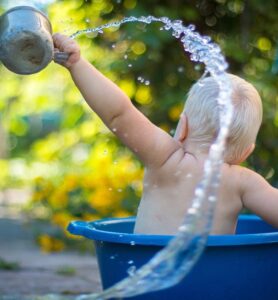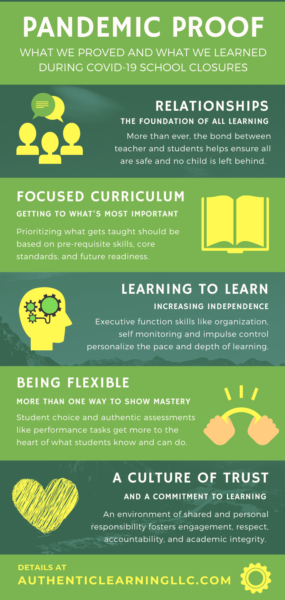If you ever experienced a domestic disaster like a water leak, it may have been a blessing in disguise.
When systems get disrupted, we uncover problems that should have been fixed long ago. Heeding Churchill’s advice of “Never let a good crisis go to waste,” you may have used the recovery process as an opportunity to mitigate future damage– replacing pipes, upgrading fuses, purging old boxes of clothes or papers. And you may have found daily living improved as a result.

The pandemic has been a water leak in our schools and communities.
It’s easy not to think about the plumbing when everything’s running fine. Or were we just ignoring the odd noises, drips, and signs of rust? Were we afraid to go under the sink for fear of a big job we might have to take on?
Enter a once-in-a-lifetime pandemic. Addressing the emergency exposed weaknesses and identified gaps in our awareness of how things functioned. It showed us what might be worth saving, what we could improve upon, and what should be discarded.
We succeeded in getting teachers and students online and providing essential services, from meals to therapy. But the bar during COVID-19 was, of necessity, dropped pretty low. Now that we’re daring to think about life beyond the pandemic, our standards of success need to and can rise again, even to new heights.
Under pressure, schools learned to do better.
In the first few weeks of remote operations, we targeted the most emergent shortcomings in our systems through triage. Gradually, we came to a place of some stability. Now we are thinking about what we can take away from the experience to improve schools well into the future. Here are some of the most critical understandings emerging:
1. We Must Continuously Address Equity.
Inequity was practically built into the founding of the first schools, which were “separate but not equal.” The factory model classroom of the late 19th century furthered the problem by prioritizing standardized instruction over individual needs. (Not coincidentally, private schools for the wealthy ballooned from that point on, furthering disparities.) In many ways that’s never left us.
Equity issues became even more apparent during the COVID crisis. The most obvious were unequal access to technology and the ability of parents to support home learning.
But there’s so much more. Schools are rethinking the disparate, ineffective, and often biased ways we label, group, assess, place, discipline, communicate, and choose resources for students of diverse backgrounds, experiences, and needs. These will continue to be impediments for the students subject to them until we meaningfully address them.
2. Strong Mental Health and Relationships Are Our Baseline.
To learn well, students must feel they belong, are safe, and are cared for and about. Research and experience consistently correlate strong social bonds between teachers and students with improved learning.
During school closings, teachers went to greater lengths than ever to understand better not only how well their students were achieving academically, but how they were doing socially, emotionally, and psychologically. They strengthened relationships between schools and guardians to support students working at home like never before. Many consider these deeper levels of involvement to be the new norm.
We should also look at what advantages some students experienced during home learning. Freed from certain classroom pressures, provided more flexibility, and creating their own comfortable environments, what can we continue to provide to help them feel even more at home in school?
3. Be Flexible and Flex Your Creative Muscles.
Evolution does not favor the “best” traits, but the most adaptive to the environment. Educators modified schedules, instruction, and curriculum, often on the fly. Tests and quizzes that didn’t work well online made way for videos, portfolios, performance tasks, open ended questions, and other more authentic assessments. Many allowed students new creative ways to participate, express themselves, and demonstrate mastery.
Educators can’t plan for every contingency, but we can design curriculum that is inherently more flexible, with options, alternatives, and a focus on big ideas that can be explored in numerous ways. (Bamboo bends in a storm when mighty pines get uprooted!)
4. Teach Children How to Learn.
When students couldn’t be at arm’s length, we had to work harder with them on how to learn as much as we did on what to learn. Executive functioning skills like organization, impulse control, and self monitoring became more vital for students to be able to work when not under the direct influence of their teacher. Developing such skills should always be embedded in every curriculum. They bring us that many steps closer to our ultimate goal of personalizing learning and building independence.
5. Make Your Curriculum Living. (Really.)
Because of reduced live interactions and due to challenges teaching content in an online format, we had to prioritize what we taught. We worked to get the most bang for our buck from each lesson, and focused on high interest activities, core standards, and future readiness. Less became more. Regular curriculum reviews and revisions should adopt the same mindset.
6. Find Better Ways to Assess Work.
According to a recent EdWeek survey, the rate of class failures is likely to more than double during remote learning. Many districts modified grading systems to allow students to demonstrate mastery in new ways, often of their choosing. Tests and quizzes that didn’t work well online made way for videos, portfolios, performance tasks, open ended questions, and more authentic assessments.
Business and behavioral studies find that the modern workforce emphasizes productivity over hours. The pandemic has surely redefined offices and office hours. Time on task has always been difficult to define (being busy doesn’t always equate to engaged learning). And every person works at a different pace. Instead of worrying about how many minutes are spent working, we should be far more concerned about outcomes.
7. Build a Culture of Growth and Commitment.
A community’s culture is its set of shared beliefs, language, and practices. It influences everything they do. Schools and classrooms that have been able to develop cultures of trust, respect, a commitment to learning, and a belief in academic integrity show more peer collaborations; improved student initiative, empowerment, and accountability; and less absenteeism, mental stress, and concerns about cheating. (These also happen to be characteristics and byproducts of a growth mindset.)
8. Use Technology to Address and Not Exacerbate Problems.
If you didn’t have a love-hate relationship with tech before remote operations, I’ll bet you do now. Even when it worked, it wasn’t always suited to the purpose. A Zoom grid is clearly not the same as being in the same space with your students. Then again, having 24/7 access to assignments, resources, recordings, and communications could benefit many children moving forward.
During the crisis, more than ever, we’ve had to look at tech as the means to an end. With limited time and resources, we made Darwinian decisions about devices, apps, and platforms. We posed questions we should always have been asking: How does this improve learning? How easy is it to use? How are we measuring the cost-benefit? In what ways does it align with and promote our priorities? How does it directly address student needs?
I see many school leaders who were innovators and paradigm breakers in 2019 who would be grateful just to get back to the status quo before the 2021-22 school year begins. Big thinking and big plans can come back later, maybe even the following year. But they won’t without foresight and intention.

Be mindful of what you might lose when emptying the bathwater.
The lessons above came hard won by thousands of dedicated professionals in thousands of classrooms. It is understandable to want to put this time behind us. But let’s not squander what we’ve learned about ourselves, our students, our communities, our leaders, and our educational system during this crisis.
If we simply return to the ways things were, whether out of habit, inertia, entropy, or exhaustion, we won’t just be ill-adapted for future emergencies. We will have wasted an opportunity to become better.
⚙ Dr. Marc
 We are all lifelong learners (or else we chose the wrong profession!). And who better to learn from than fellow educators and practitioners? If you have a friend or colleague who speaks this kind of language, or would benefit from hearing it, feel free to forward this post.
We are all lifelong learners (or else we chose the wrong profession!). And who better to learn from than fellow educators and practitioners? If you have a friend or colleague who speaks this kind of language, or would benefit from hearing it, feel free to forward this post.
©2020 Marc Natanagara, Ed.D. All rights reserved. Reprinted with permission. This article and other resources available at authenticlearningllc.com
When duplicating this post in any form, please include the attribution above.
Baby images from https://pixabay.com Free for commercial use. No attribution required.
Marc Natanagara, Ed.D. ⚙ Winter 2020→ 2021





